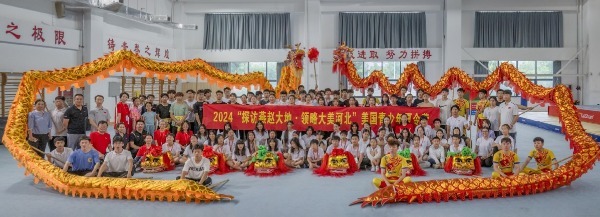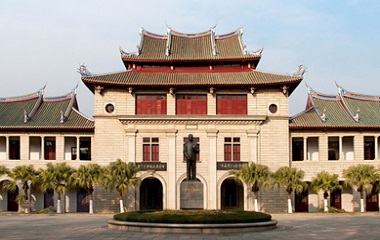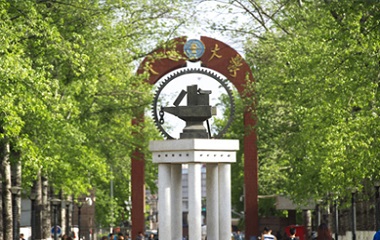
For some it's a trip of cultural discovery filled with awe-inspiring moments; for others it's a journey to seek heritage and identity, which can be intense and sometimes emotional.
Whatever the experiences bring them, US students traveling to China this summer to take part in theme camps have learned to appreciate differences. More importantly, the exposure to China's culture and people is conducive to forming a well-rounded and profound perception of the country.
"These 10 days will definitely broaden my vision," said Amy Gao, 12, a seventh grader who flew from the San Francisco Bay Area to attend an exchange and study program in Hebei province. With 174 other peers and team leaders from across the United States, Amy started her "exploration and adventure" in China on June 26.
A culturally rich ceremony was organized in Shijiazhuang, Hebei's capital, to welcome the young visitors. Hebei, one of the birthplaces of Chinese civilization, was called the State of Yan and Zhao during the Spring and Autumn and Warring States periods (770-221 BC).
"Organizers are so welcoming that they spare no effort showcasing to us literally, everything," Amy said. The wonders they encountered ranged from an internationally recognized Wuqiao acrobatics performance to Hebei bangzi, a genre of local opera featuring singing, reciting, acting and martial arts performances with accompanying Chinese instruments such as the banhu, a two-stringed fiddle, and dizi, the bamboo flute.
Ren Zhuoping, vice-chairwoman of the Hebei Provincial Overseas Chinese Federation, told US students at the ceremony that they would get to immerse themselves in China's 5,000 years of history and culture, experience the rapid growth and changes of contemporary China, and gain a deeper, vivid understanding of the country's breadth.
"Through what you see, hear and feel in Hebei, each and every one of you can serve as a young ambassador for cultural exchanges between China and the US and a bridge connecting peoples," she said.
Samantha Tow, a second-year high school student from California, was making her first trip to China. "The acrobatic performance at the opening ceremony is simply breathtaking and astounding," she said, adding that she also tried on Chinese costumes with traditional makeup and hairdo. "The color of my outfit is peacock green and azure, very Chinese."
Campers also went sightseeing at an ancient Buddhist temple and a section of the Great Wall and learned paper-cutting, Chinese painting, calligraphy and tea presentation.
"Lots of different activities, very interesting," said Selina Fang, a middle schooler from California.
The eye-opening activities also included observations on the street. "I don't see so many electric vehicles on American streets as opposed to China," she said.
Dong Xudong, who spent two months starting in April helping recruit US students for the Hebei camp, said such programs are important because they improve understanding and exchanges.
"To maintain healthy and normal China-US relations, we need to sow seeds of mutual understanding and friendship in the hearts of young generations in China and the US," he said.
Interaction between youth
At a summit in San Francisco in November China said it would invite 50,000 US students to visit on exchange and study programs in the next five years to increase interaction between the two peoples, especially between youth.
Young people are quick learners, they have many common interests transcending national boundaries, and they naturally befriend each other, said Xiaopei He Gelb, founder of a dance troupe in Tri-Valley, California.
Last month Gelb took her students to the Dance Academy of Southern China, a local professional dance school in Dongguan, Guangdong province, for a camp at which her girls received eight days of intensive professional training.
"My students only went to dance class twice a week in two-hour sessions in the United States," Gelb said. "So it came as no surprise that they called the first day traumatic and catastrophic after learning to bend, stretch, split, glide and jump in a professional way. Many were crying due to pain, swelling limbs, fatigue and frustrations."
However, Gelb's students persevered because "local dancers, bigger sisters and brothers at the academy have set good examples".
"They impress our children not only because they can deliver very difficult moves, but their grit, their pursuit to be a better self. Those (are) stellar traits that I want my students to cultivate and possess."
Kelly Ma, just 12, but who has been learning from Gelb for more than seven years, attended the camp.
"We've learned and changed so much because of the amazing teachers that helped us grow from the second they met us," Kelly said. "It may have been difficult and different from what we were used to, but no one gave up."
The "difficult and different" aspects of the programs, said Alan Gao, a parent team leader with the Hebei camp, are an integral part of cross-cultural exchanges and collaboration.
"The American children encounter language barriers, cultural shock, homesickness and unfamiliarity with team members, different kinds of challenges besides scorching weather there. But they learn and grow from overcoming obstacles."










